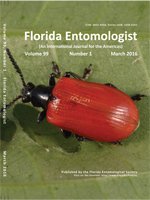We report the results from surveys conducted in 2013 and 2014 to monitor insecticide susceptibility in Florida field populations of the Asian citrus psyllid, Diaphorina citri Kuwayama (Hemiptera: Liviidae). These surveys are a component of the insecticide resistance management program for D. citri, which is the vector of ‘Candidatus’ Liberibacter asiaticus. ‘Candidatus’ Liberibacter asiaticus is the plant pathogen that causes citrus greening disease. The insecticides evaluated (carbaryl, chlorpyrifos, dimethoate, fenpropathrin, flupyradifurone, imidacloprid, and thiamethoxam) represent several modes of action and are among those that are currently used to manage D. citri in commercial groves in Florida. The 2013 and 2014 surveys revealed a decrease in the resistance ratios at the 50% response level (RR50) as compared with the 2009 survey, which was the last time this parameter was investigated. The results of the 2013 and 2014 surveys suggest a reversal to pre-2009 susceptibility levels in D. citri populations statewide for all modes of action tested. These results suggest that implementation of effective rotations and area-wide management of this pathogen vector may have contributed to insecticide stewardship.
How to translate text using browser tools
1 March 2016
Reversal of Insecticide Resistance in Florida Populations of Diaphorina citri (Hemiptera: Liviidae)
Monique R. Coy,
Liu Bin,
Lukasz L. Stelinski

Florida Entomologist
Vol. 99 • No. 1
March 2016
Vol. 99 • No. 1
March 2016
flupyradifurone
insecticide resistance management
manejo de resistencia a los insecticidas
monitoring program
neonicotinoid
Neonicotinoides
programas de monitoreo




